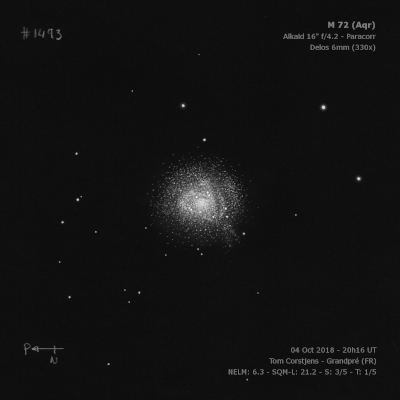
Pierre Méchain discovered M72 = NGC 6981 = h2090 on 30 Aug 1780. First observed by Herschel on 28 Sep 1783 using his 8-inch (10-ft focal length) and noted as "fairly resolved into small stars." WH made a detailed observation on 30 Oct 1810 using the 40-foot telescope (48-inch): Having been about 20 minutes at the telescope to prepare the eyes properly for seeing critical objects, the 72nd of the Connois came into the field. It is a very bright object. It is a cluster of stars of a round figure, but the very faint stars on the outside of these sorts of clusters are generally a little dispersed so as to deviate from a very perfect circular form; the telescopes which have the greatest light shew this best. It is very gradually extremely condensed in the center, but with much attention even there the stars may be distinguished. Power 280x. There are many stars in the field of view with it, but they are of many magnitudes and totally different from the excessively small ones that compose the cluster. It is not possible to form an idea of the number of stars that may be in such a cluster, but I think we cannot estimate them by hundreds. The diameter is about 1/5 of the field = 1' 53".6." John Herschel also resolved this cluster on 4 Oct 1825: "F; R; gbM; resolved into very small stars; 2 or 3' diam."
300/350mm - 13.1" (9/29/84): very mottled non-symmetrical appearance with a bright core. Roughly a dozen stars are resolved mostly on the east side of the core. A brighter mag 13.5 star is in the NE side of the halo.
400/500mm - 17.5" (7/17/01): at 380x, the halo is very irregular and the globular has a very uneven surface brightness. The non-symmetrical halo is elongated ~E-W, perhaps 4'x3'. The brighter 1.5' core is covered with a sprinkling a 8-10 faint stars. From the core there are short ragged extensions to the SW and NW with a few resolved stars. More prominent is a nearly detached clump on the east side which is extended ~N-S and contains roughly 8 easily resolved stars over haze. In total, perhaps two dozen stars are resolved in moments of good seeing.
17.5" (8/13/88): very mottled at 280x, 3' diameter. About 20 stars are resolved at the edges and over the core.
17.5" (8/2/86): very mottled, ragged irregular appearance. 15-20 stars resolved over the disc.
Notes by Steve Gottlieb